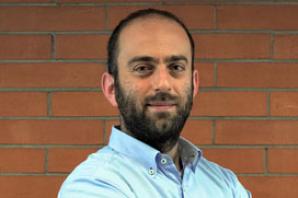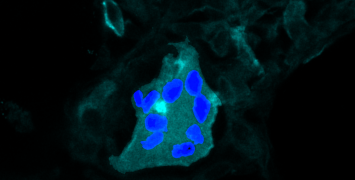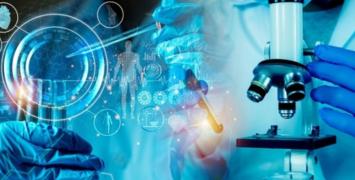Building intelligent cell-inspired microrobots
Imagine intelligent microrobots capable of finding their own path through body tissues. They could enable many revolutionary medical procedures, including targeted drug delivery, long-term monitoring and non-invasive interventions in organs such as brain. They could also allow scientists to study the migration of immune and cancer cells within the human body. ERC grantee Stefano Palagi plans to make this dream a reality, by mimicking features of immune cells.

Microrobots have a great potential for medical applications. But building them is not simply about miniaturising existing robotic technologies. Current flaws limit their application - such as their inability to move effectively in bodily fluids and tissues. Enabling microrobots to move and reach their target is a rather challenging task, for which scientists often seek inspiration in nature.
Researchers mostly look at simple microorganisms such as bacteria, and to some extent, sperm cells. These can swim in fluids, and also sense and act in response to their environment, despite their lack of a central nervous system to control those functions.
'Most scientists want to develop microrobots that can move in the bloodstream or in other body fluids. However, my frontier research aims to create microrobots able to move inside tissues. This can’t really be done using microrobots inspired by swimming bacteria’, says Stefano Palagi, assistant professor at the BioRobotics Institute of Scuola Superiore Sant'Anna in Italy and principal investigator of the CELLOIDS project. He aims to create a radically new method for designing microrobots.
Palagi and his team want to develop tiny, autonomous robots of about the same size, squishiness, and ability to move as immune cells. In particular, they want to create microrobots inspired by white blood cells, which are the fastest cells to move through body tissues by changing their shape. Their squishiness allows them to move through tiny openings without breaking the surrounding tissue apart.
Watching this video you are accepting Youtube cookies policy
Intelligent behaviour and supervised autonomy
Most existing microrobots are controlled externally, by, for example, changing the direction and intensity of an external magnetic field while tracking the robots using various imaging techniques. However, current medical imaging technologies don't allow scientists to see - at micro-scale level and in real time - the openings and obstacles that microrobots encounter in tissues. This is like driving blind.
To address this weakness, Palagi proposes something called “supervised autonomy”. It would allow his microrobots to exhibit cell-like intelligent behaviours by perceiving conditions in the environment, autonomously navigating and avoiding obstacles while also being externally supervised. 'Without sensors or microchips on board, this becomes extremely challenging to design and build. We will tackle this with a bottom-up approach, starting from the matter from which our microrobots are made, adds Palagi.
The project team will first explore how to build their microrobots based on active nanoparticles that can move by, for example, consuming fuel from their environment - or in response to chemical gradients (differences in concentration of chemicals that cause movement of molecules).
It has already been shown that when there are many of these active particles gathered together, they can also perform collective behaviours like swarming and self-organisation. These recall the behaviour of internal cellular components, and could enable microrobots to move and behave like cells. The project team will therefore investigate how to harness these behaviours and implement them in their microrobots.
Studying migration of immune and cancer cells
‘In bio-inspired microrobotics, we first look at the natural to develop the artificial. Nonetheless, this also allows us to do another way around – we could then look at the artificial as a model to understand nature better’, says Palagi.
Developing microrobots capable of moving through tissues would not only allow the project team to test and tune how they work but also enable other scientists to use these microrobots as a platform for studying the migration of immune and cancer cells within the body.
‘For example, cancer cells sometimes move into tissues by means of the same so-called amoeboid movement that immune cells use. It would help researchers to test their hypothesis on how cancer cells move in tissues’, says Palagi, who embarked upon his biomedical engineering career with the intention to make a difference in the world and help others.
Moving the field of microrobotics forward
To achieve his ambitious goals, Palagi is currently focused on building a team of biomedical engineers, chemists, physicists, and experts with biological or medical backgrounds. ‘Microrobotics is highly multidisciplinary, which makes everything more challenging, yet, ultimately more exciting’, explains Palagi.
In addition to enabling his research work, he says that the ERC grant has already been beneficial for his career, allowing him to get a tenure track assistant professor position at the BioRobotics Institute of Scuola Superiore Sant'Anna.
‘It was a big step in my career. The ERC Starting Grant enabled me to become an independent PI, build my group and buy instruments. It allowed me to pursue my research goals. This wouldn’t be possible without the ERC grant’, says Palagi.
He highlights that the ERC support is moving the whole field forward at a much faster pace than it would move otherwise. ‘In fact, the biggest microrobotics community is in Europe, and it has a strong global position’.
Bio
Stefano Palagi is an assistant professor at the BioRobotics Institute of Scuola Superiore Sant'Anna Italy. He obtained a master degree in Biomedical Engineering from the University of Pisa in Italy and a PhD in “Innovative Technologies – Biorobotics” from the Scuola Superiore Sant’Anna. He has been a postdoctoral researcher at the Max Planck Institute for Intelligent Systems and at the Istituto Italiano di Tecnologia. His research interests are at the intersection of bioengineering, robotics and AI as well as material science.






